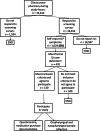Self-medication and ILI etiologies among individuals presenting at pharmacies with influenza-like illness: Guatemala City, 2018 influenza season
- PMID: 35962425
- PMCID: PMC9374570
- DOI: 10.1186/s12889-022-13962-8
Self-medication and ILI etiologies among individuals presenting at pharmacies with influenza-like illness: Guatemala City, 2018 influenza season
Abstract
Objectives: We aimed to characterize the proportion of clients presenting to community pharmacies with influenza-like illness (ILI) and the severity of their illness; the proportion with detectable influenza A, influenza B, and other pathogens (i.e., parainfluenza I, II, and III, adenovirus, respiratory syncytial virus, human metapneumovirus); and to describe their self-medication practices.
Methods: A cross-sectional study was conducted in six pharmacies in Guatemala City. Study personnel collected nasopharyngeal and oropharyngeal swabs from participants who met the ILI case definition and who were self-medicating for the current episode. Participants were tested for influenza A and B and other pathogens using real-time RT-PCR. Participants' ILI-associated self-medication practices were documented using a questionnaire.
Results: Of all patients entering the pharmacy during peak hours who responded to a screening survey (n = 18,016) 6% (n = 1029) self-reported ILI symptoms, of which 45% (n = 470/1029) met the study case definition of ILI. Thirty-one percent (148/470) met inclusion criteria, of which 87% (130/148) accepted participation and were enrolled in the study. Among 130 participants, nearly half tested positive for viral infection (n = 55, 42.3%) and belonged to groups at low risk for complications from influenza. The prevalence of influenza A was 29% (n = 35). Thirteen percent of the study population (n = 17) tested positive for a respiratory virus other than influenza. Sixty-four percent of participants (n = 83) reported interest in receiving influenza vaccination if it were to become available in the pharmacy. Medications purchased included symptom-relieving multi-ingredient cold medications (n = 43/100, 43%), nonsteroidal anti-inflammatory drugs (n = 23, 23%), and antibiotics (n = 16, 16%). Antibiotic use was essentially equal among antibiotic users regardless of viral status. The broad-spectrum antibiotics ceftriaxone and azithromycin were the most common antibiotics purchased.
Conclusions: During a typical influenza season, a relatively low proportion of all pharmacy visitors were experiencing influenza symptoms. A high proportion of clients presenting to pharmacies with ILI tested positive for a respiratory virus. Programs that guide appropriate use of antibiotics in this population are needed and become increasingly important during pandemics caused by respiratory viral pathogens.
Keywords: Antibiotics; Influenza Like Illness; Pharmacy based study.
© 2022. The Author(s).
Conflict of interest statement
The authors declare that they have no competing interests.
Figures

References
-
- Homedes N, Fugh-Berman A. Pharmacies and the pharmaceutical industry in Latin America. World Med Health Policy. 2019;11:188–202. doi: 10.1002/wmh3.307. - DOI
Publication types
MeSH terms
Substances
LinkOut - more resources
Full Text Sources
Medical
Miscellaneous

